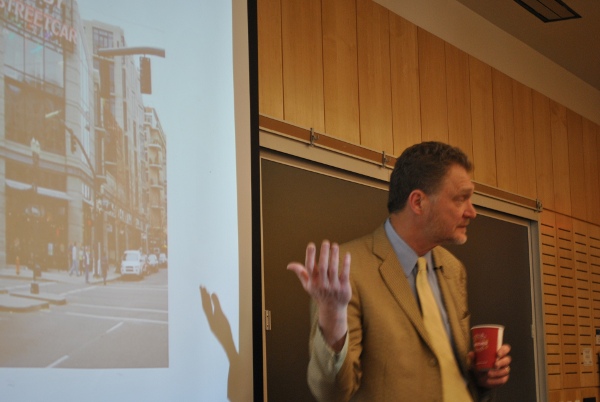A siren wails and the question looms, will the ambulance, fire engine or police car get where it needs to in time?
The answer depends on the design of the town or city.
“You could either have this suburban kind of street network or you could have the street grid,” said Jacky Grimshaw, an urban transportation analyst at the Center for Neighborhood Technology (CNT) in Chicago, standing in front of two maps side by side for effective comparison.
“And the same amount of distance takes you longer if you have to go around here,” she said, pointing to the giant artery road whose handful of offshoots fed the winding branches of suburban cul de sac development. “If you’re having a heart attack and you want the ambulance there in a hurry, if it has to go through all of these streets to get to you, you’re dead.”
“Who should be responsible for this,” asks John Norquist, President of the Congress for New Urbanism (CNU), referring to the infrastructure cost of building suburban sprawl, and the cost of providing fire service to it.
Norquist was the mayor of Milwaukee from 1988-2004, a period when the city experienced an urban renaissance.
“If you have a street grid you can service lots of people, lots of houses with a certain amount of fire service,” Norquist said, “but if everyone lives in a cul de sac then you need three or four times as many fire personnel to be able to service them at the same level.”
According to CNU, a study in Charlotte, North Carolina, indicating the per capita costs for fire service increased from $159 in the portion of the city with the best-connected street grid network to $740 in the least connected zone.
Grimshaw and Norquist both participated in a discussion on “Rethinking our Cities” as part of the Northwestern University Summit on Sustainability that took place in early April. The two made the point that infrastructure, specifically roads, are not something that necessarily needs protection, as much as they need to function effectively to protect citizens.
In 2010, both the CNT and CNU collaborated with the Institute of Transportation Engineers, the main standards body for road designers, to create a design manual for urban thoroughfares.
“It’s available for free download at ite.org,” said Norquist. “It gives communities the option of building smaller-scale streets, of building grids of streets instead of giant roads.” (Details at http://www.ite.org/css/ )
When asked how things might improve Norquist pointed out that roughly half of the built-environment will be transformed in the next 30 years and “about half of the housing will be new in some form.” Building it on a more urban pattern than it is now will lead all sorts of gains in efficiency, like improved public safety and, also important, reduced energy consumption.
CNU is also leading an effort to narrow suburban streets. A study in Longmont, Colorado by Swift-Painter-Goldstein, a transportation planning consultancy, indicated a 485 percent increase in accident rates per mile when streets are widened from 24 to 36 feet.
Narrow streets encourage walking and slower traffic speeds, making the overall environment safer for walkers, bikers and drivers alike. And with a well-designed grid street network, alternative routes for emergency response vehicle are available and accessible.
Congestion, the bane of traffic engineers for decades, is okay it turns out. “If you’re a business-person on Main Street you really like congestion,” says Grimshaw. People are looking into store windows. “They are shopping even though they may be moving through the neighborhood.”






